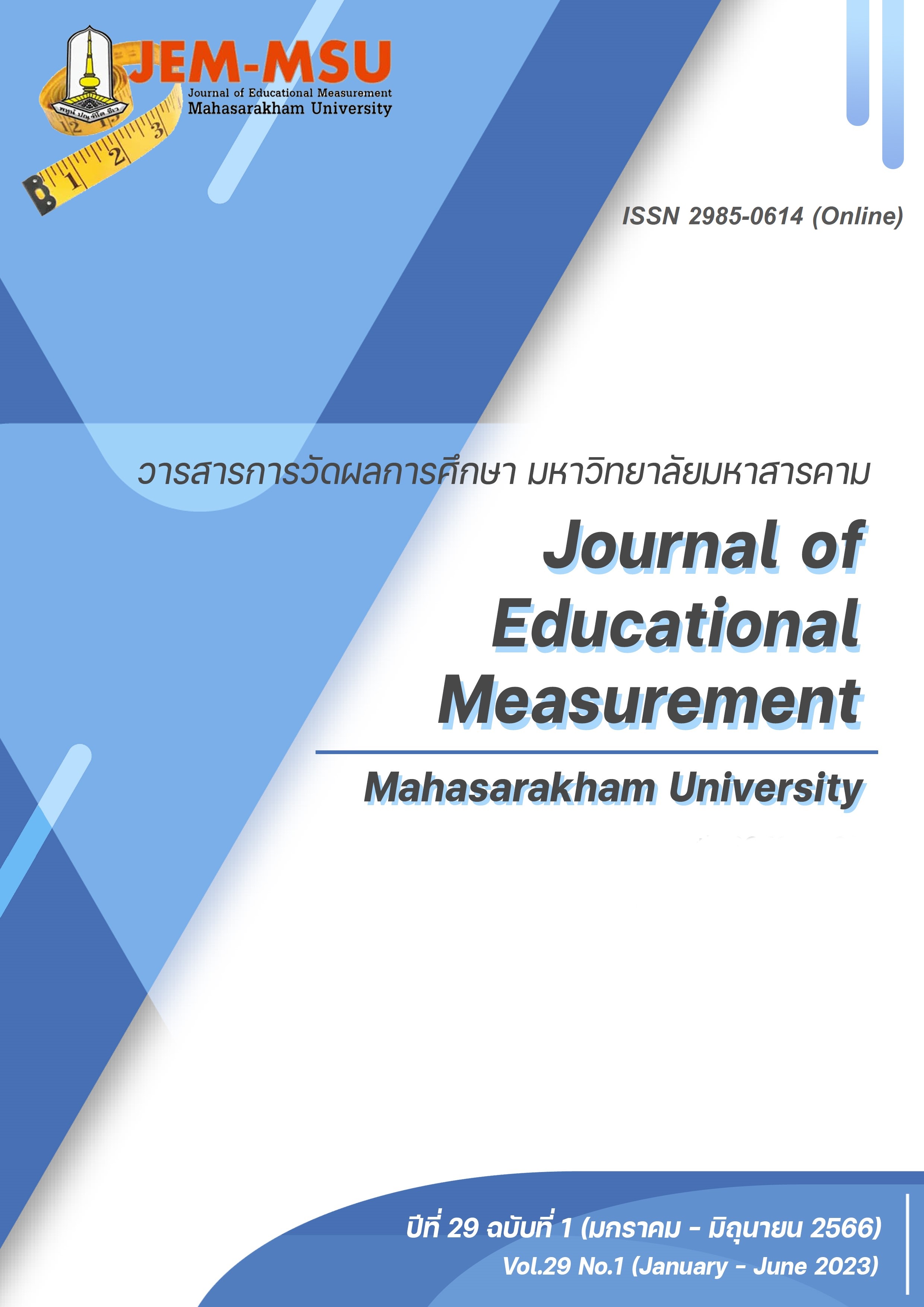A Model for Development of Digital Learning Culture in Primary Schools under Chaiyaphum Primary Education Service Area Office 3
Main Article Content
Abstract
The research employed mixed methods, with the following objectives: 1) to study the components and indicators of digital learning culture in primary schools under Chaiyaphum Primary Education Service Area Office 3; 2) to examine the consistency of the indicator model of the digital learning culture in primary schools under Chaiyaphum Primary Education Service Area Office 3, that the author had constructed, with empirical data; 3) to create and evaluate a model for development of digital learning culture in primary schools under Chaiyaphum Primary Education Service Area Office 3. The sample of 270 administrators and teachers was obtained by multistage sampling. The tool used for data collection was a 5-level rating scale questionnaire with the content validity between 0.80 to 1.00 and the total reliability of 0.967. The analysis of data employed descriptive and inferential statistics and SPSS program. Confirmatory factor analysis (CFA) was performed with the Mplus program. Drafting of the model was carried out by interviewing, followed by assessing the suitability, possibility and usefulness of the model.
The research results were as follows:
1. The digital learning culture in primary schools consisted of 5 elements: 1) digital blended personnel training, having 2 indicators with 5 behavioral indicators; 2) on-line social collaboration values, having 2 indicators with 5 behavioral indicators; (3) digital competency, having 3 indicators with 8 behavioral indicators; (4) digital leadership, having 3 indicators with 8 behavioral indicators; (5) digital learning environment, having 3 indicators with 7 behavioral indicators. Totally, the digital learning culture in primary schools under Chaiyaphum Primary Education Service Area Office 3 had 5 components, 13 indicators and 33 behavioral indicators.
2.The test results of the model of the digital learning culture in primary schools, developed by the author, were consistent with the empirical data as having the values of = 56.948, df = 43,
/ df = 1.324, P-Value = 0.0754, RMSEA = 0.035, SRMR = 0.023, CFI = 0.996, TLI = 0.992.
3.The evaluation results of the model for development of digital learning culture in primary schools revealed that the model consists of the name, principle and concept, objective, achievement goal, and mechanism for success. The result of the model evaluation indicated that the model was suitable, possible and useful at the highest level.
Article Details

This work is licensed under a Creative Commons Attribution-NonCommercial-NoDerivatives 4.0 International License.
The content and information contained in the published article in the Journal of Educational Measurement Mahasarakham University represent the opinions and responsibilities of the authors directly. The editorial board of the journal is not necessarily in agreement with or responsible for any of the content.
The articles, data, content, images, etc. that have been published in the Journal of Educational Measurement Mahasarakham University are copyrighted by the journal. If any individual or organization wishes to reproduce or perform any actions involving the entirety or any part of the content, they must obtain written permission from the Journal of Educational Measurement Mahasarakham University.
References
Hair, J. F., Black, W. C., Babin, B. J., & Anderson, R. E. (2010). Multivariate Data Analysis. (7th Ed.). Prentice Hall.
Keeves, J. P. (1997). Models and model building. In Keeves, J.P. (Eds.). Educational research, methodology and measurement: An International Handbook (2nd Ed.). Oxford Peraman Press.
The Joint Committee on Standard for Education Evaluation. (1994). The program evaluation standards: How to assess evaluations of educational programs. Sage.
Ward, G. (2020). How To Build A Digital Learning Culture In Your Organization. https://elearningindustry.com/build-digital-learning-culture-organization
Wit, M. D. & Dompseler, H. V. (2017). How to create a digital learning environment consisting of various components and acting as a whole?. https://www.eunis.org/download/2017/EUNIS_2017_paper_16.pdf
Buason, R. (2013). Qualitative research in education (4th Ed.). Chulalongkorn University. (in Thai)
Chaiyaphum Primary Educational Service Area Office 3. (2021). The 5-year Educational Development Plan B.E. 2564 - 2568 (A.D. 2021-2025). https://web.chaiyaphum3.go.th/files/pat_plan65.pdf (in Thai)
Chutcham, S. (2004). A Confirmatory Factor Analysis. Research Educational Measurement and Evaluation journal, 2(1), 15-42.
Jarupoom, A. (2016). A Study of the Competency of Information Technology Personnel to Support the Digital Economy of Government Agencies: A Case Study of the Center for Information and Communication Technology, Office of the Permanent Secretary, Ministry of Finance [Master’s Independent Research]. Thammasat University. (in Thai)
Khonkan, S. (2004). The Development of Indicators of State Higher Education Institutions. [Doctoral dissertation]. Srinakharinwirot University. (in Thai)
Lakthong, S. (2019). Developing an integrated training model based on self-leading principles to enhance digital literacy capabilities For teachers under the Office of the Basic Education Commission [Doctor’s dissertation]. Mahasarakham University. (in Thai)
Ministry of Information and Communication Technology. (2016). Digital Development Plan for Economy and Society. Ministry of Information and Communication Technology. (in Thai)
Office of the Permanent Secretary for Ministry of Agriculture and Cooperatives. (2012). Organizational Culture Analysis. https://www.opsmoac.go.th/km-km_org_center- files-391991791962 (in Thai)
Sathukitchai, k. (2020). 10 ways to cope with Work From Home with technology. https://www.smethailandclub.com/startups-5578-id.html (in Thai)
Srisa-ard, B. (2017). Preliminary research (10th Ed.). Suwiriyasan. (in Thai)
Thawinkarn, D. (2021). Digital Leadership (2nd Ed.). Teaching Innovation Center Khon Kaen University. (in Thai)


